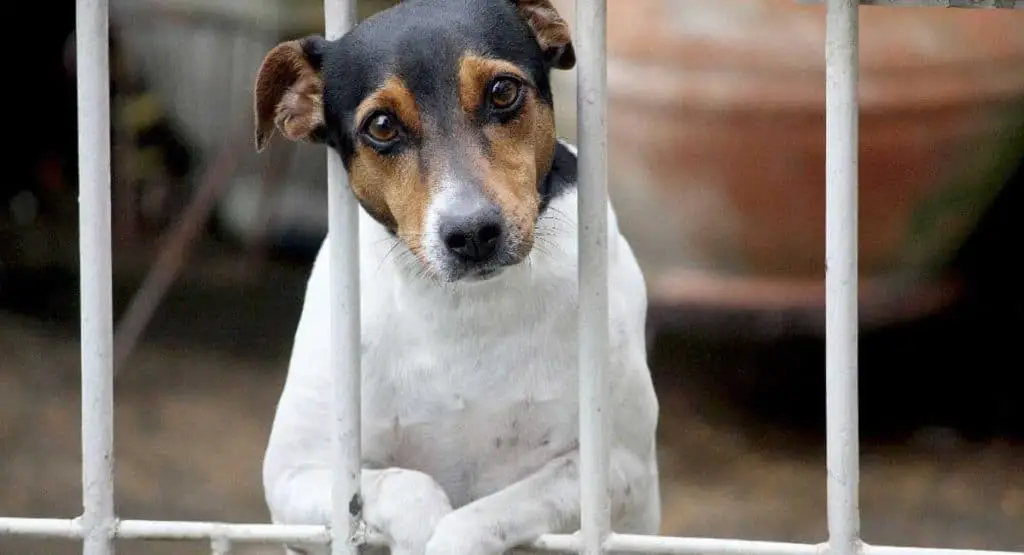If you’ve ever gone on a weekend trip, or been called away due to an emergency without plans for someone to watch your dog, you may have been forced to leave your dog home alone. In those moments away, thinking about if you’ve left enough food out, you may have wondered, “how long can a dog go without food?”
In general, dogs can go from anywhere between five days to three weeks without eating before sustaining permanent injury or illness. However, the length of time a dog can go safely without food depends on a variety of factors, from the size and age of the dog, to how much that dog needs to move a day, to how hot the temperature is.
All of that said, a pet shouldn’t be allowed to go without eating for more than a couple of days.
There are also a number of reasons why a dog would voluntarily go without eating, including illness, stress, and change in routine. If you notice that your dog hasn’t eaten in a couple of days, it’s best to call your veterinarian to schedule an appointment.
Several serious diseases begin to manifest with a lack of appetite, so it’s important to not let your dog go too long without eating, and as important as food is, water is even more important. If your dog goes without drinking for more than a day, contact your vet immediately.
Reasons Why a Dog May Stop Eating
There are primarily 3 reasons why a dog may stop eating. They can range from minor to serious, so if your dog goes without eating for 48 hours or more, be sure to schedule an appointment with your vet.

They’re a Picky Eater
Like us, sometimes a dog just doesn’t want to eat certain foods. A number of reasons could be the cause for this picky behavior.
New Food
If your dog doesn’t seem to be eating as much after you change their food, it probably is a sign that they just don’t like the new food you’ve given them. At times, dogs may have to go on a diet, or be switched to a healthier food. This change in food could prompt your dog to stop eating.
Too Many Treats
If you’re prone to giving your dog scraps from the table, or too many doggie treats, they may stop eating their normal food. Dogs may avoid their food in order to gorge themselves on treats instead.
Tired of Old Food
Just as if you had to eat the same thing for breakfast, lunch, and dinner everyday, dogs may just get sick of eating the same old food. While they may have enjoyed it at first, dogs can tire of eating the same food every day.
A Change in Lifestyle
A number of routine changes may cause your dog to stop eating due to distress or depression.
New Surroundings
If you’ve recently moved your pet to a new location, it may stress them out, or even cause them some light depression. Dogs become used to routines, and new surroundings change those routines.
A New Pet
The introduction of a new pet to your home can cause some behavioral issues in your dog, and refusing to eat may be one of them.
A New Baby
As with a new pet, a new baby in the house will break up routines that your dog may have gotten used to. If you notice a change in your dog’s appetite with the addition of a new family member, this may be the reason.
Illness
The most serious reason your dog has stopped eating could be due to an illness. There are a number of different illnesses that could cause your dog to stop eating, ranging from minor to severe. If your dog doesn’t eat for more than two days, you should contact your veterinarian.
Teeth or Gum Problems
If your dog develops problems to its teeth or gums, it most likely will cause it to stop eating. Many problems with teeth or gums can be minor, but some may not be, so a call to your vet should be scheduled.
Pancreatitis
A fairly common illness in dogs, pancreatitis is when the pancreas becomes inflamed and forces enzymes out into the rest of the body. Minor pancreatitis may last for only a day or two, but a serious case can potentially be fatal to your pup.
Parvo
Parvo is a virus that causes severe diarrhea and vomiting, and can potentially be fatal to dogs. The great risk with Parvo is that your dog will become severely dehydrated. If your dog refuses to eat or drink for more than a day, you should get them to your vet immediately.
Surgery
As with humans, a dog may feel nauseated and disoriented after any surgery, which may prevent them from eating. It’s best to wait until the effects of any anesthesia wear off before trying to get your dog to eat. If they refuse to eat or drink for more than a day after their surgery, it’s best to reach out to your vet to try and figure out why.
The Dangers of Not Eating
While going a day or two without food most likely won’t affect your pup too much, going longer than that can cause specific problems. Decreased alertness, diminishing activity level, and negative changes in your dog’s behavior can all result from not eating.
Decreased Alertness
A dog that goes for days without eating will become less alert as time goes by. This can cause minor problems, such as your dog not coming to you when you call, or larger ones, such as your dog not being able to avoid injury.
Diminishing Activity Level
The longer your dog goes without eating, the more lethargic they will become. This can cause issues such as going to the bathroom on the floor instead of going outside, or becoming dehydrated due to not drinking. This can further exacerbate any illness your dog may have.
Aggressiveness
Dogs that aren’t getting proper nutrition can become agitated and even aggressive. The hungrier a dog is, the more likely they are to act aggressively, even if they never have before.
How to Get Your Dog to Eat
If your dog is eating for behavioral reasons, rather than illness, there are a number of steps you can take to try to get your dog to eat. If they are not eating because of a health problem, taking them to the veterinarian may be your only option.
Switch Their Food
If a dog refuses to eat a new food, or stops eating their old one, a change in food may be all they need. As annoying as it may be for an owner, dogs can sometimes be stubborn and picky about what they’ll eat. If you suspect your dog is being picky, you may have no choice but to switch food.
Try Peanut or Almond Butter
A spoonful (or half a spoonful for smaller dogs) of peanut or almond butter on top of their food may entice your dog to eat it. For dry food, you can even mix the food and the peanut or almond butter. Be sure to buy natural nut butters with no artificial ingredients, as these may be harmful to your dog.
Cut Back on Treats
If your dog is not eating its food, but is begging for more doggie treats or table scraps, you may need to cut back in order to get them to eat their food. Dogs may try to get away with only eating treats in place of their food.
Offer Chicken or Beef Broth
Especially good for a dog recovering from an illness or surgery, a small amount of beef or chicken broth may whet their appetite. Start off with a small amount, then gradually increase it as your dog recovers. You can even pour it over their food when they’re healthy enough for solid foods again.
Be Patient
If your dog is not eating due to a change in routine, it’s best to be patient and let them acclimate to their new conditions in place of trying to force them. As they become used to the new routines, they should begin eating again at their own pace.
Foods to Never Give Your Dog
Despite the temptation to feed your dog some of your favorite food in order to get them to eat, there are a number of people foods that are harmful to dogs.
Some of the foods that you should NEVER give your dog include:
- Chocolate
- Certain nuts, macadamia nuts in particular
- Grapes
- Undercooked or raw eggs or meat
- Artificial sweeteners
- Onions
- Salt
- Caffeinated drinks including coffee, tea, and soda
Leaving Your Dog Home Alone
If you must leave your dog home alone, be sure to provide them with as much food and water as is necessary. Twice as much water as food should be left, especially if your dog is staying outside. An automatic water bowl is best, since it will automatically continue to fill your dog’s water dish, and can’t be knocked over as easily.

If it’s necessary to leave your dog alone for more than 24 hours, you should always have someone able to check up on your dog, and to refill their food or water. If possible, boarding your dog will be the best way to make sure that they get everything they need while you are away.
Leaving your dog alone for more than 24 hours could lead to possible health problems and illnesses, especially if they are being left outside.
Final Thoughts
So, how long can a dog go without food?
Depending on a number of different factors, such as age and size of the dog, a dog can technically go without eating for anywhere between five days to three weeks, in extreme circumstances. However, a pet shouldn’t be allowed to go without eating after 48 hours without medical attention or other attempts to get them to eat.
Love you guys,
JTB
P.S. If you’re new to this world, you may want to check out my Ultimate Guide for First Time Dog Parents. It’s a great reference to get you started on this journey.
This article has been reviewed by our Editorial Board and has been approved for publication in accordance with our Editorial Policies.
Disclaimer: The Can My Dog articles contain information based on the individual research and opinions of the author of the site – who just so happens to be a dog. How you utilize the information given is completely up to you. Proceed at your own risk.
